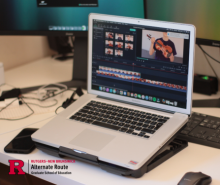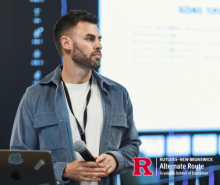Have New Jersey Teacher Shortages Thwarted Alternate Route Teacher Diversity?
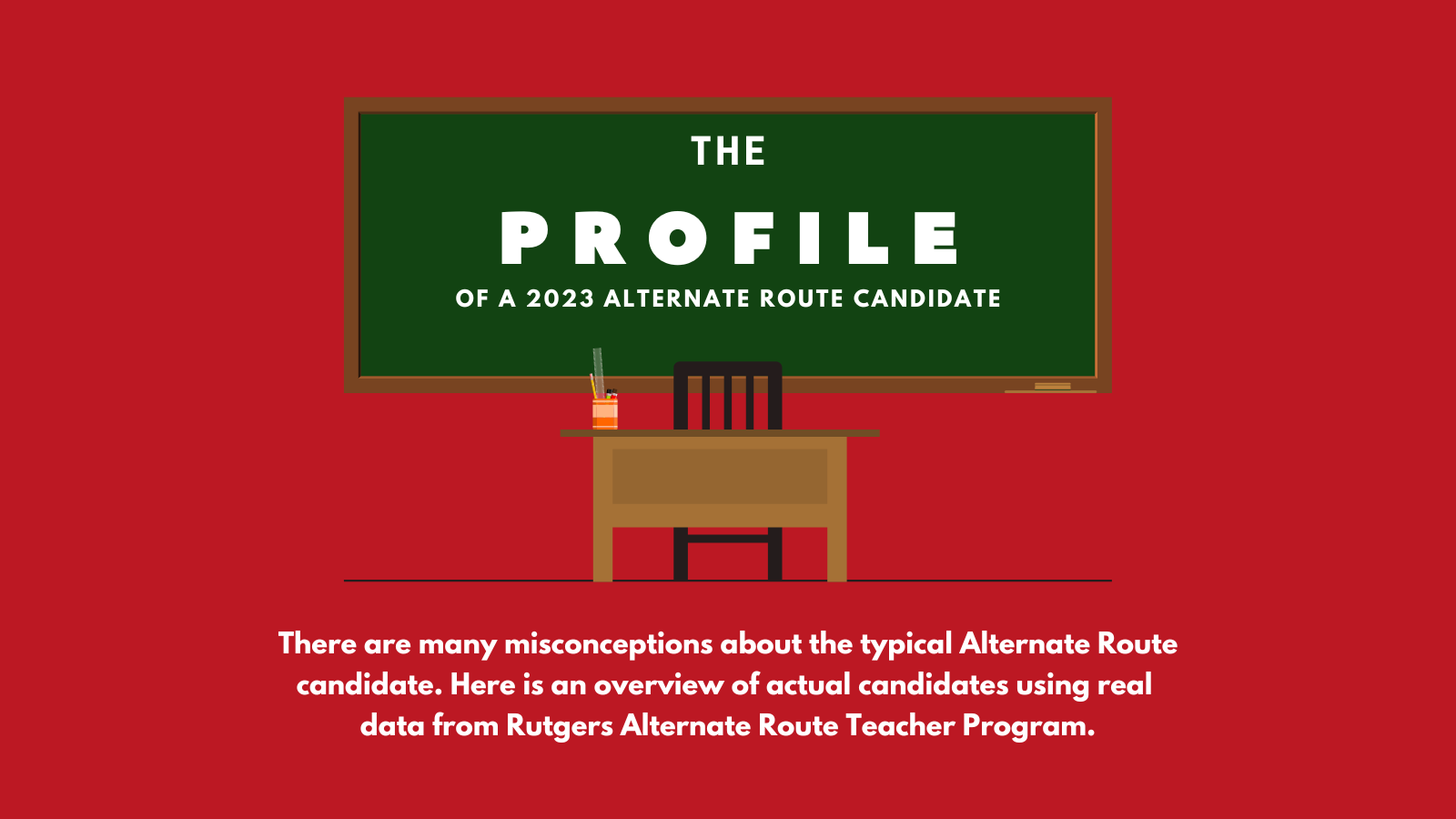
The Alternate Route program at the Rutgers Graduate School of Education is dedicated to increasing teacher diversity and addressing the need for a more inclusive teaching workforce in New Jersey. By actively recruiting and supporting nontraditional teachers, the program has expanded the pool of new teachers in the workforce and improved the diversity of teaching candidates. Our message to candidates is clear: There's a place for individuals from all backgrounds and ages in the teaching profession.
In addition, we strive to normalize the presence of male teachers in elementary classrooms and female teachers in STEM positions, while also supporting nonbinary and LGBTQ+ teachers entering the profession. Our cohort demographics reflect the varying backgrounds, ages, and experiences of our candidates whose presence in the teaching profession helps to create a more inclusive and diverse educational environment for students.
Racial and Ethnic Diversity in the Classroom
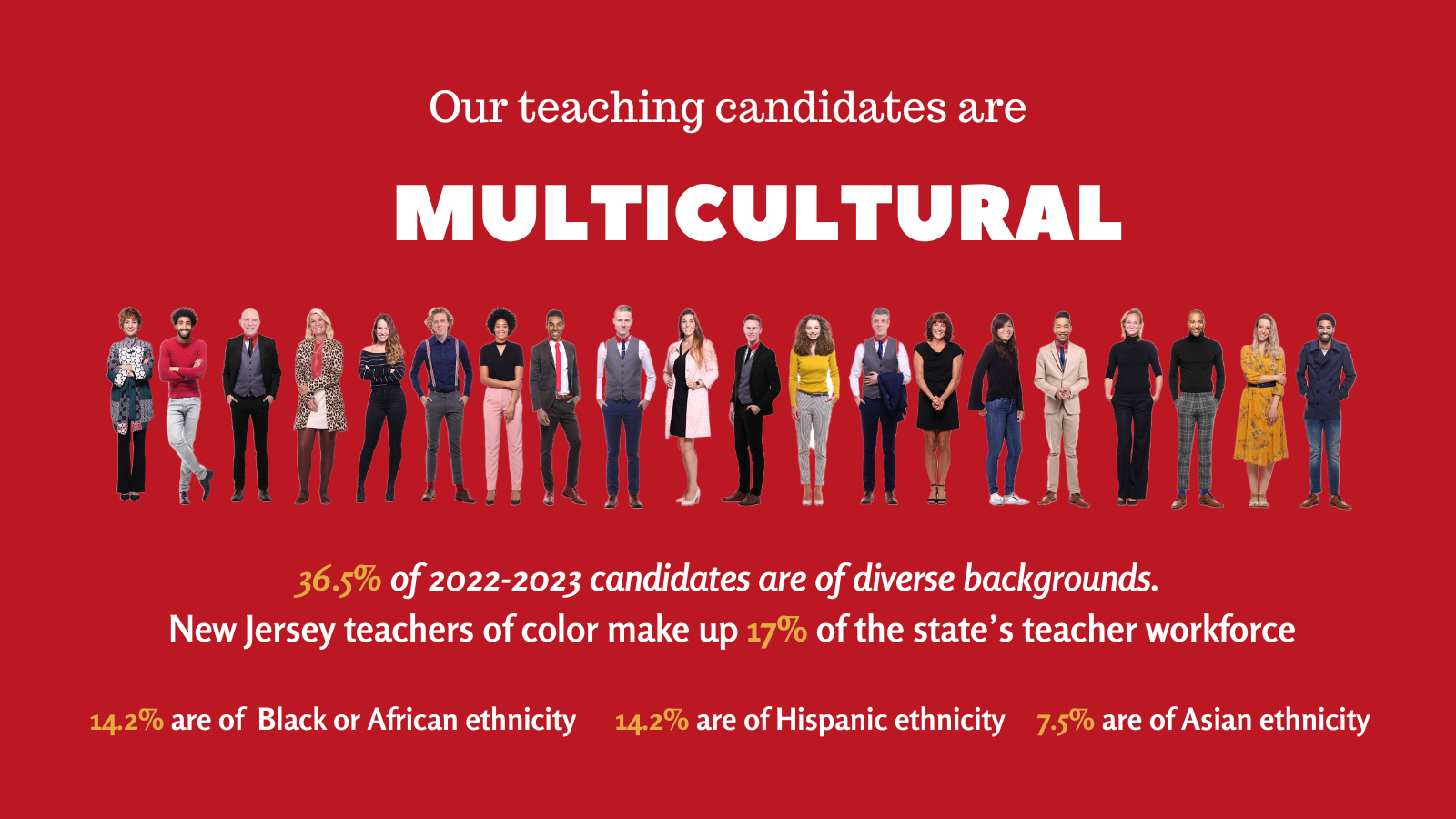
The importance of fostering a truly inclusive and enriching educational environment has never been more important as K-12 classrooms continue to grow increasingly diverse, reflecting the many cultural, racial and ethnic backgrounds that shape our national identity. Across the country, schools are responding to this diversity with teacher recruitment efforts that demonstrate their commitment to embracing and celebrating our multiculturalism and heterogeneity. They understand that a diverse teaching workforce benefits all students and supports the creation of more equitable educational environments that also help students expand their perspectives.
Data published by the New Jersey Department of Education tells us that the state's teaching force is less diverse than its students. Roughly 56 percent of the state’s student population is Hispanic, Black, or Asian, however, only a mere 16 percent of teachers are educators of color. For students of color, having teachers of the same race or ethnicity helps them attain greater educational success by closing achievement gaps, serving as role models, taking a restorative rather than punitive approach to discipline, and increasing graduation and college enrollment rates. What's more is that teachers of color are linked to social-emotional and academic gains for students of all races.
District hiring trends reflected by the 2022-2023 candidates enrolled in the Rutgers Alternate Route program are promising.
The cohort demographic report shows diversity in the teaching candidates' racial backgrounds, with representation from various groups:
Most teaching candidates are white, representing approximately 63% of the candidate pool.
Almost 37% of the candidate pool identifies as Hispanic, Black, or Asian, which is more than double the state average of nonwhite teachers.
Black or African American and Hispanic candidates make up around 14% each, showing significant representation among the candidates.
Asian candidates represent approximately 7.54% of the candidate pool, while Native American and Bi-Racial candidates each account for about 0.3%.
Overall, the data indicate a trend toward improved teacher diversity championed by the state because of its benefits to the overall education system. A diverse pool of teaching candidates allows for a broader range of perspectives, experiences, and cultural backgrounds to be represented in the classroom while fostering cultural understanding, empathy, and appreciation for different perspectives—all of which can lead to better academic and social outcomes for all students.
Closing the Gender Gap in STEM
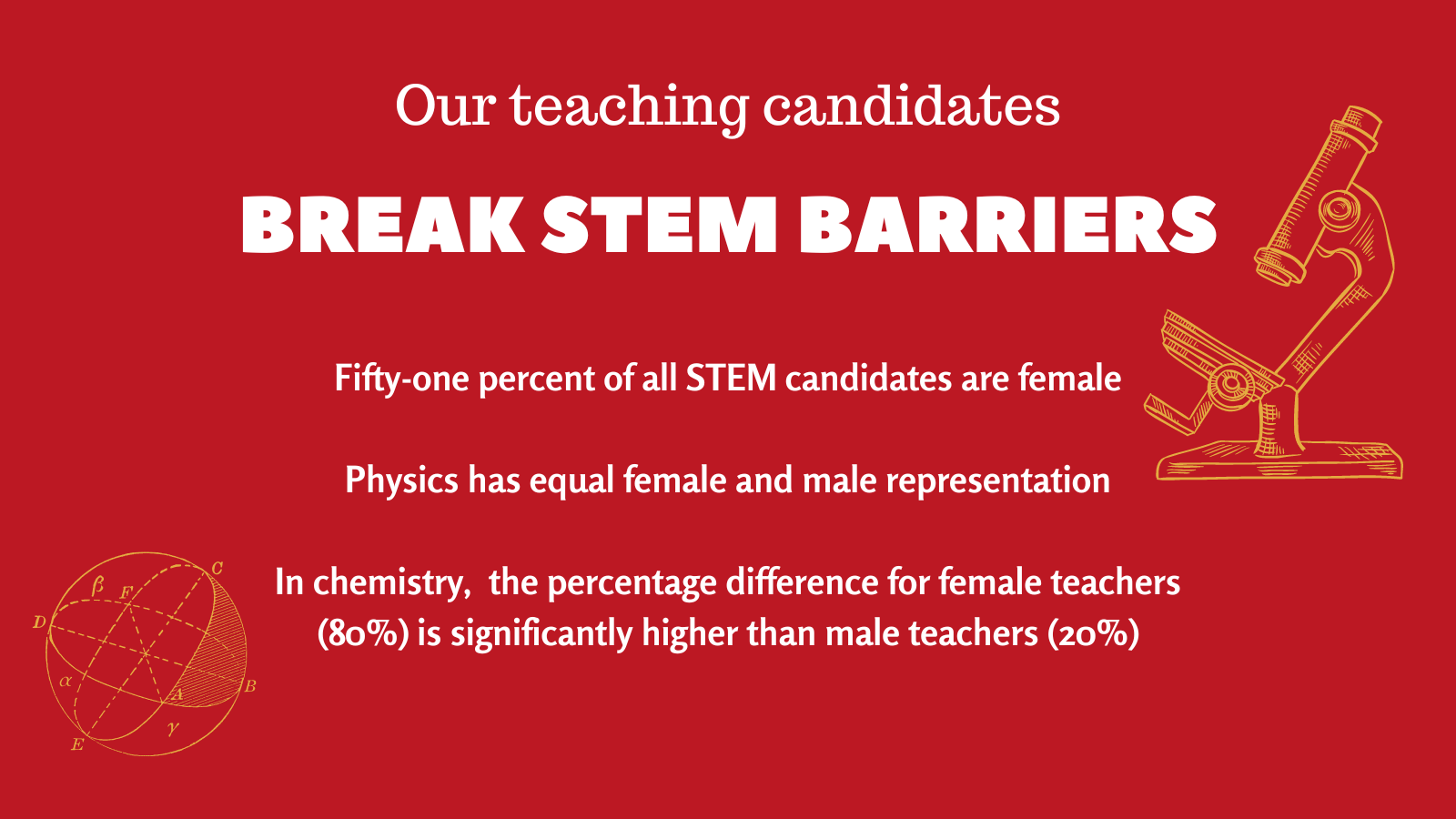
Increasingly in the U.S., Science, Technology, Engineering, and Mathematics (STEM) drives our innovative capacity and knowledge economy, resulting in a higher demand for STEM workers capable of helping the nation maintain its global competitiveness. However, it's no secret that women are woefully underrepresented in STEM workforce, making up about just 27 percent of STEM workers nationally, according to a 2019 Census report.
The persisting gap in STEM gender diversity has also emerged as a pressing concern for the K-12 sector where educators understand the vital role that early STEM exposure can play in addressing the underrepresentation of women in these fields. Their recruiting efforts aim to increase the number of female STEM teachers, and thereby help students of any gender see themselves as STEM achievers with future careers in related fields.
Progress toward STEM diversity goals is reflected in the district hiring trends indicated by our Rutgers Alternate Route program cohorts. The cohort demographic report shows women are gaining ground in securing positions as teachers of science and math at the middle and secondary school levels. In fact, the overall percentage of female teachers of STEM subjects is slightly more than that of male teachers.
Fifty-one percent of all STEM teachers are female, while 47% are male and one is non-binary.
The representation of female teachers (86%) is significantly higher than male teachers (14%) in middle school math. For the middle school science teacher categories, 75% of teachers are female while 25% are male.
In contrast, there is a higher representation of male teachers in secondary school math and biology, 52% and 53% respectively. However, female teachers for these subjects represent 44% and 47% of the workforce, which demonstrates only a small gap.
Physics shows an equal number of male and female teachers.
Notably, chemistry is the only secondary school subject area where the female teacher (80%) percentage difference is significantly higher than male teachers (20%).
Encouraging more women to pursue teaching in STEM and providing support and professional development opportunities for teachers of all genders help narrow the gender gap in STEM education. Women's representation in STEM classrooms not only empowers young girls to envision themselves as future scientists, engineers, and innovators but also enriches the educational experience for all students, while simultaneously breaking down stereotypes in these traditionally male-dominated fields.
Alternate Route Candidates Represent Diverse Age Groups
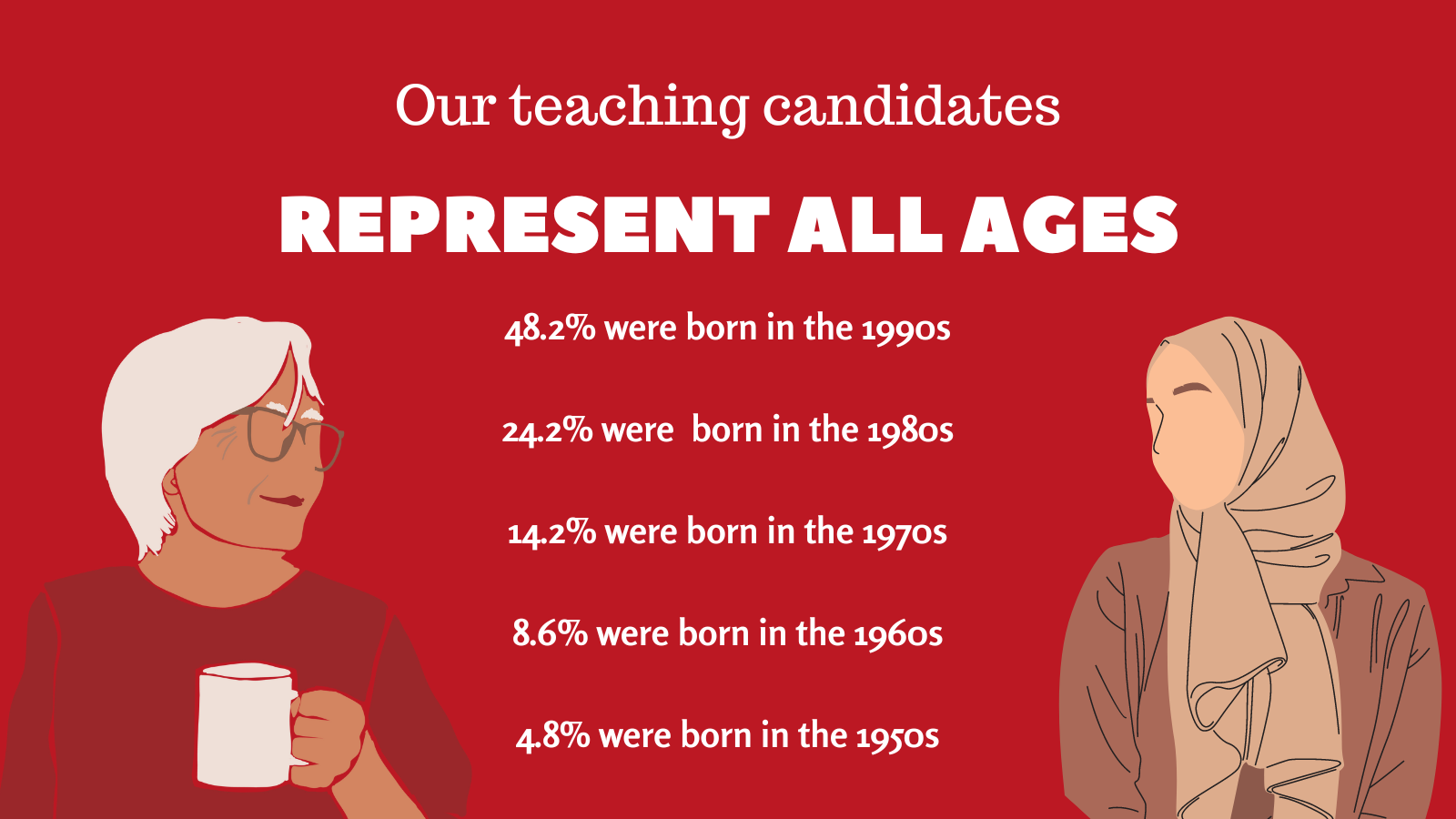
Racial and STEM-gender diversity may be more pressing priorities in education nationally, but districts in New Jersey demonstrate a clear interest in age-diverse teaching staff as well. They recognize that skills, abilities and potential come in all ages and embrace age-equity hiring practices. Our demographic data shows that our cohort of teachers includes a mix that spans baby boomers and GenX to Millennials and GenZ. This diverse group of educators, ranging from our eldest candidate at 68 to the youngest at 21, brings a wealth of life experience, wisdom, and passion to education. Together they create intergenerational school environments that help advance mutual student and teacher learning while also cultivating a unique professional community for educators and other staff.
Most teaching candidates (approximately 48%) were born in the 1990s, indicating that individuals from this decade are the most represented group among the candidates. Below are other data we found:
Candidates born in the 1980s (approximately 24%) and 1970s (about 14%) also comprise significant portions of the candidate pool.
There is a decline in the number of candidates as we go back in time, with a relatively small representation of candidates born in the 1960s (approximately 8.64%) and the 1950s (about 1.95%).
Candidates born in the 2000s have the least representation (approximately 2.79%), likely due to being younger and potentially having fewer individuals born in this decade eligible for teaching positions.
Clearly, there is a diverse age distribution among teaching candidates, with a prominent representation of individuals born in the 1990s, followed by candidates from the 1980s and 1970s. Consistent with previous years, there is a relatively low percentage of candidates from earlier decades, perhaps due to retirement prior to pursuing teaching. Nevertheless, the persistent presence of mature adults in our cohorts demonstrates it’s never too late to begin a career in teaching. Their decision to transition into teaching reflects a deep commitment to making a difference in students' lives, and their unique perspectives enrich the learning environment for all. As they embark on new career paths as teachers, they inspire each other and forge meaningful connections, contributing to dynamic school communities where age is leveraged as an asset.
Alternative teacher certification programs enable Americans of all ages and backgrounds to pursue teaching as a second, third, or even fourth career, resulting in a diverse educator workforce, even amid teacher shortages. Rutgers Alternate Route is proud to play a key role in expanding access to the teaching profession, diversifying representation in New Jersey classrooms, and supporting the vibrant tapestry of educators who hope to leave an indelible impact on the students they touch.
If you’re considering following your dream of teaching, Rutgers Alternate Route can offer you the support and training you need to succeed. Be sure to follow Rutgers Alternate Route on Twitter or sign up for Alternate Route’s monthly newsletter for more information and stories from the field of education.

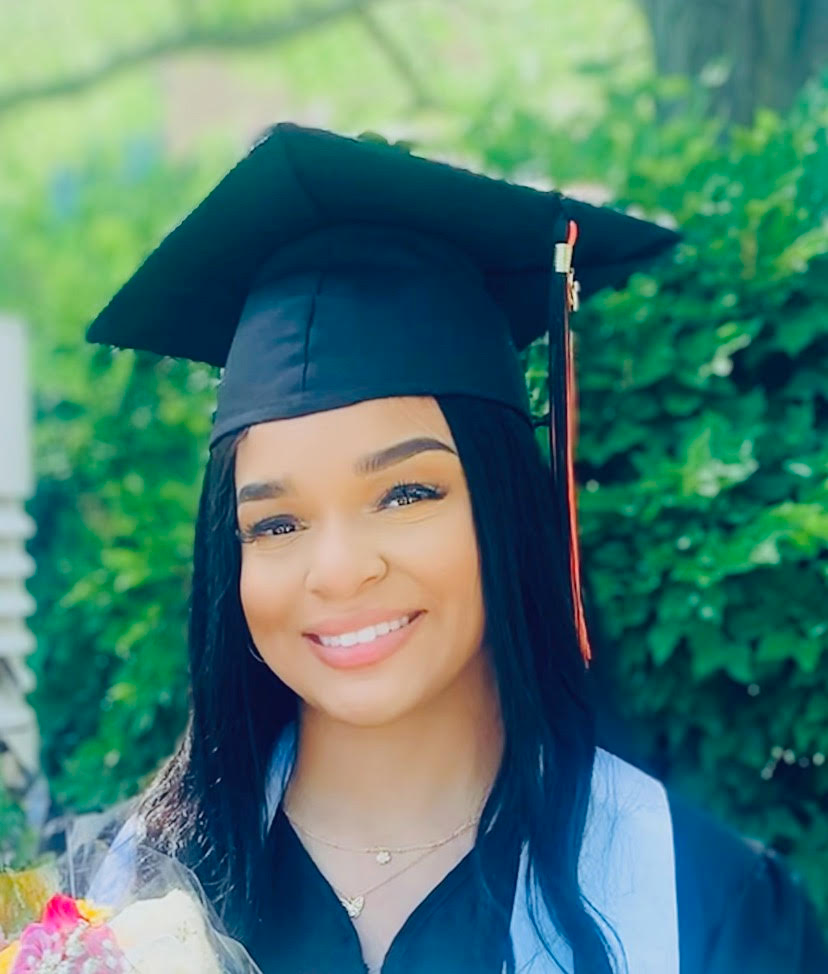 DeMariah Woodard is an undergraduate student at Niagara University where she is a double major in Psychology and Criminal Justice. She supports content creation initiatives with Black Star Communications as a Digital Communications Intern for Summer 2023. Published works by DeMariah are completed in collaboration with the Rutgers Alternate Route Team and Black Star Communications.
DeMariah Woodard is an undergraduate student at Niagara University where she is a double major in Psychology and Criminal Justice. She supports content creation initiatives with Black Star Communications as a Digital Communications Intern for Summer 2023. Published works by DeMariah are completed in collaboration with the Rutgers Alternate Route Team and Black Star Communications.
